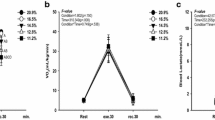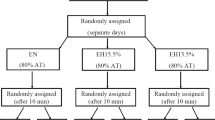Abstract
Purpose
To investigate the effect of voluntary hypocapnic hyperventilation or moderate hypoxia on metabolic and heart rate responses during high-intensity intermittent exercise.
Methods
Ten males performed three 30-s bouts of high-intensity cycling [Ex1 and Ex2: constant-workload at 80% of the power output in the Wingate anaerobic test (WAnT), Ex3: WAnT] interspaced with 4-min recovery periods under normoxic (Control), hypocapnic or hypoxic (2500 m) conditions. Hypocapnia was developed through voluntary hyperventilation for 20 min prior to Ex1 and during each recovery period.
Results
End-tidal CO2 pressure was lower before each exercise in the hypocapnia than control trials. Oxygen uptake (\(\dot{V}{\text{O}}_{ 2}\)) was lower in the hypocapnia than control trials (822 ± 235 vs. 1645 ± 245 mL min−1; mean ± SD) during Ex1, but not Ex2 or Ex3, without a between-trial difference in the power output during the exercises. Heart rates (HRs) during Ex1 (127 ± 8 vs. 142 ± 10 beats min−1) and subsequent post-exercise recovery periods were lower in the hypocapnia than control trials, without differences during or after Ex2, except at 4 min into the second recovery period. \(\dot{V}{\text{O}}_{ 2}\) did not differ between the control and hypoxia trials throughout.
Conclusions
These results suggest that during three 30-s bouts of high-intensity intermittent cycling, (1) hypocapnia reduces the aerobic metabolic rate with a compensatory increase in the anaerobic metabolic rate during the first but not subsequent exercises; (2) HRs during the exercise and post-exercise recovery periods are lowered by hypocapnia, but this effect is diminished with repeated exercise bouts, and (3) moderate hypoxia (2500 m) does not affect the metabolic response during exercise.




Similar content being viewed by others
Abbreviations
- Acc:
-
Accommodation period
- ANOVA:
-
Analysis of variance
- BLa:
-
Blood lactate concentration
- f R :
-
Respiratory frequency
- HIE:
-
High-intensity intermittent exercise
- HR:
-
Heart rate
- P ETCO2 :
-
End-tidal CO2 pressure
- P ETO2 :
-
End-tidal O2 pressure
- RPE:
-
Rating of perceived exertion
- SB:
-
Spontaneous breathing
- SpO2 :
-
Arterial O2 saturation
- \(\dot{V}{\text{CO}}_{ 2}\) :
-
Carbon dioxide elimination
- \(\dot{V}_{\text{E}}\) :
-
Minute ventilation
- VH:
-
Voluntary hyperventilation
- \(\dot{V}{\text{O}}_{ 2}\) :
-
Oxygen uptake
- V T :
-
Tidal volume
- WAnT:
-
Wingate anaerobic test
References
Ainslie PN, Duffin J (2009) Integration of cerebrovascular CO2 reactivity and chemoreflex control of breathing: mechanisms of regulation, measurement, and interpretation. Am J Physiol Regul Integr Comp Physiol 296:R1473–R1495
Bärtsch P, Saltin B (2008) General introduction to altitude adaptation and mountain sickness. Scand J Med Sci Sports 18(Suppl 1):1–10
Bogdanis GC, Nevill ME, Boobis LH, Lakomy HK (1996) Contribution of phosphocreatine and aerobic metabolism to energy supply during repeated sprint exercise. J Appl Physiol 80(3):876–884
Borg G (1975) Simple rating methods for estimation of perceived exertion. Physical work and effort. Pergamon, New York, p 39–46
Bruce EN, Cherniack NS (1987) Central chemoreceptors. J Appl Physiol 62:389–402
Calbet JA, De Paz JA, Garatachea N, Cabeza de Vaca S, Chavarren J (2003) Anaerobic energy provision does not limit Wingate exercise performance in endurance-trained cyclists. J Appl Physiol 94(2):668–676
Chin LM, Leigh RJ, Heigenhauser GJ, Rossiter HB, Paterson DH, Kowalchuk JM (2007) Hyperventilation-induced hypocapnic alkalosis slows the adaptation of pulmonary O2 uptake during the transition to moderate-intensity exercise. J Physiol 583(1):351–364
Chin LM, Heigenhauser GJ, Paterson DH, Kowalchuk JM (2010a) Effect of hyperventilation and prior heavy exercise on O2 uptake and muscle deoxygenation kinetics during transitions to moderate exercise. Eur J Appl Physiol 108(5):913–925
Chin LM, Heigenhauser GJ, Paterson DH, Kowalchuk JM (2010b) Pulmonary O2 uptake and leg blood flow kinetics during moderate exercise are slowed by hyperventilation-induced hypocapnic alkalosis. J Appl Physiol 108(6):1641–1650
Chin LM, Heigenhauser GJ, Paterson DH, Kowalchuk JM (2013) Effect of voluntary hyperventilation with supplemental CO2 on pulmonary O2 uptake and leg blood flow kinetics during moderate-intensity exercise. Exp Physiol 98(12):1668–1682
Daly WJ, Bondurant S (1962) Effects of oxygen on the heart rate, blood pressure, and cardiac index of normal men resting, with reactive hyperemia, and after atropine. J Clin Invest 41:126–132
do Nascimento PC, de Lucas RD, de Souza KM, de Aguiar RA, Denadai BS, Guglielmo LG (2015) The effect of prior exercise intensity on oxygen uptake kinetics during high-intensity running exercise in trained subjects. Eur J Appl Physiol 115(1):147–156
Duffin J, Mohan RM, Vasiliou P, Stephenson R, Mahamed S (2000) A model of the chemoreflex control of breathing in humans: model parameters measurement. Respir Physiol 120(1):13–26
Faisal A, Beavers KR, Robertson AD, Hughson RL (2009) Prior moderate and heavy exercise accelerate oxygen uptake and cardiac output kinetics in endurance athletes. J Appl Physiol 106(5):1553–1563
Faiss R, Léger B, Vesin JM, Fournier PE, Eggel Y, Dériaz O, Millet GP (2013) Significant molecular and systemic adaptations after repeated sprint training in hypoxia. PLoS One 8(2):e56522. doi:10.1371/journal.pone.0056522
Forbes SC, Kowalchuk JM, Thompson RT, Marsh GD (2007) Effects of hyperventilation on phosphocreatine kinetics and muscle deoxygenation during moderate-intensity plantar flexion exercise. J Appl Physiol 102(4):1565–1573
Fujii N, Tsuchiya S, Tsuji B, Watanabe K, Sasaki Y, Nishiyasu T (2015) Effect of voluntary hypocapnic hyperventilation on the metabolic response during Wingate anaerobic test. Eur J Appl Physiol 115(9):1967–1974
Gaitanos GC, Williams C, Boobis LH, Brooks S (1993) Human muscle metabolism during intermittent maximal exercise. J Appl Physiol 75(2):712–719
Hayashi N, Ishihara M, Tanaka A, Yoshida T (1999) Impeding O(2) unloading in muscle delays oxygen uptake response to exercise onset in humans. Am J Physiol 277(5):1274–1281
Honda Y, Myojo S, Hasegawa S, Hasegawa T, Severinghaus JW (1979) Decreased exercise hyperpnea in patients with bilateral carotid chemoreceptor resection. J Appl Physiol Respir Environ Exerc Physiol 46(5):908–912
Juel C (1997) Lactate-proton cotransport in skeletal muscle. Physiol Rev 77(2):321–358
Kasai N, Mizuno S, Ishimoto S, Sakamoto E, Maruta M, Goto K (2015) Effect of training in hypoxia on repeated sprint performance in female athletes. Springerplus 4:310. doi:10.1186/s40064-015-1041-4
LeBlanc PJ, Parolin ML, Jones NL, Heigenhauser GJ (2002) Effects of respiratory alkalosis on human skeletal muscle metabolism at the onset of submaximal exercise. J Physiol 544(1):303–313
Maciel BC, Gallo L Jr, Marin-Neto JA, Lima Filho EC, Martins LEB (1986) Autonomic nervous control of the heart rate during dynamic exercise in normal man. Clin Sci 71(4):457–460
McLellan TM, Kavanagh MF, Jacobs I (1990) The effect of hypoxia on performance during 30 s or 45 s of supramaximal exercise. Eur J Appl Physiol Occup Physiol 60(2):155–161
Ogawa T, Hayashi K, Ichinose M, Wada H, Nishiyasu T (2007) Metabolic response during intermittent graded sprint running in moderate hypobaric hypoxia in competitive middle-distance runners. Eur J Appl Physiol 99(1):39–46
Plet J, Pedersen PK, Jensen FB, Hansen JK (1992) Increased working capacity with hyperoxia in humans. Eur J Appl Physiol 65:171–177
Puype J, Van Proeyen K, Raymackers JM, Deldicque L, Hespel P (2013) Sprint interval training in hypoxia stimulates glycolytic enzyme activity. Med Sci Sports Exerc 45(11):2166–2174. doi:10.1249/MSS.0b013e31829734ae
Roth DA, Brooks GA (1990) Lactate and pyruvate transport is dominated by a pH gradient-sensitive carrier in rat skeletal muscle sarcolemmal vesicles. Arch Biochem Biophys 279:386–394
Rousseau A, Bak Z, Janerot-Sjöberg B, Sjöberg F (2005) Acute hyperoxaemia-induced effects on regional blood flow, oxygen consumption and central circulation in man. Acta Physiol Scand 183(3):231–240
Rowell LB, O’Leary DS (1990) Reflex control of the circulation during exercise: chemoreflexes and mechanoreflexes. J Appl Physiol 69:407–418
Spriet LL, Lindinger MI, Heigenhauser GJ, Jones NL (1986) Effects of alkalosis on skeletal muscle metabolism and performance during exercise. Am J Physiol Regul Integr Comp Physiol 251:R833–R839
Tabata I, Nishimura K, Kouzaki M, Hirai Y, Ogita F, Miyachi M, Yamamoto K (1996) Effects of moderate-intensity endurance and high-intensity intermittent training on anaerobic capacity and VO2max. Med Sci Sports Exerc 28(10):1327–1330
Ward SA, Whipp BJ, Koyal S, Wasserman K (1983) Influence of body CO2 stores on ventilatory dynamics during exercise. J Appl Physiol 55(3):742–749
Weyand PG, Lee CS, Martinez-Ruiz R, Bundle MW, Bellizzi MJ, Wright S (1999) High-speed running performance is largely unaffected by hypoxic reductions in aerobic power. J Appl Physiol 86(6):2059–2064
Acknowledgements
We appreciate all subjects volunteered for the present study. We also greatly appreciate the help of Dr. William Goldman for English editing and critical comments. The article was funded by Ministry of Education, Culture, Sports, Science and Technology in Japan (Grant No. 25,242,061).
Author information
Authors and Affiliations
Corresponding author
Ethics declarations
Conflict of interest
The authors declare that they have no competing interests.
Additional information
Communicated by Susan Hopkins.
Rights and permissions
About this article
Cite this article
Dobashi, K., Fujii, N., Watanabe, K. et al. Effect of voluntary hypocapnic hyperventilation or moderate hypoxia on metabolic and heart rate responses during high-intensity intermittent exercise. Eur J Appl Physiol 117, 1573–1583 (2017). https://doi.org/10.1007/s00421-017-3646-5
Received:
Accepted:
Published:
Issue Date:
DOI: https://doi.org/10.1007/s00421-017-3646-5




